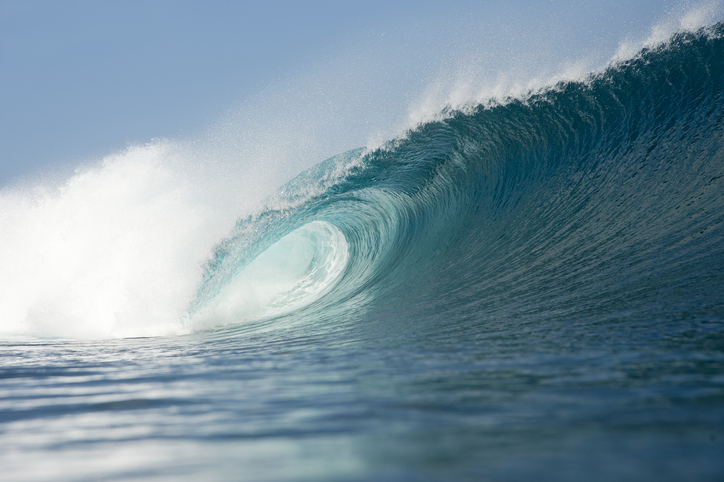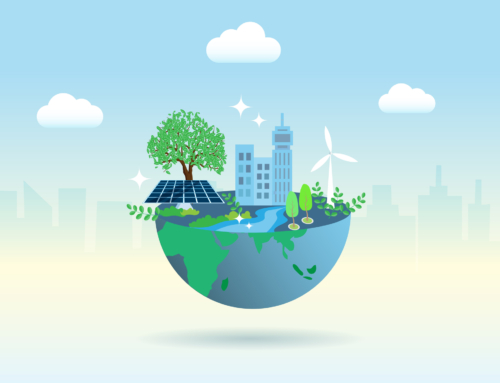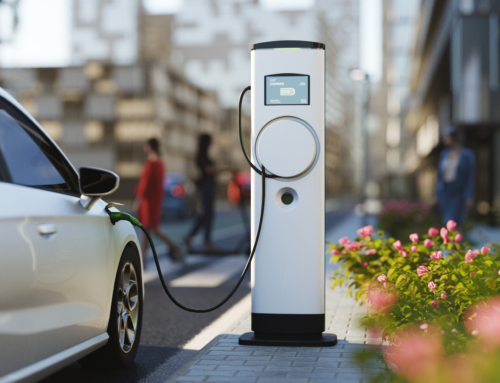Ocean waves contain tremendous energy potential since the wind blows nearly constantly enough to provide consistent waves in many areas of the world. Add in the rhythmic tides and powerful currents that course beneath the surface of the seas and we’ve got mind-boggling quantities of kinetic energy ready to be harnessed for renewable electricity for coastline communities across the world.
The instability in oil prices, the seriousness of environmental issues, and the finiteness of resources have increased interest in ocean wave energy since the 1970s, but public demand for a renewable and sustainable source of electricity is now higher than ever. It is expected that the next couple of decades will bring big “waves” to this burgeoning industry.
What Is Ocean Wave Energy?
If you’ve ever seen an old-fashioned grain or sawmill that uses a water wheel to power the equipment, you have a general idea of how ocean wave energy works.
Waves are powerful forces of motion, and that motion is a form of energy called kinetic energy. As wind moves ocean water, this energy builds. Other forces, like landslides, earthquakes, and volcanic eruptions, can also cause waves or that movement of energy. Harnessing the power of those waves can provide an enormous amount of usable electricity once it has been converted.
Just as a windmill turns the wind’s kinetic energy into usable electricity, the same theory and technology can be reinvented to harness the movement of ocean waves. Scientists are working on finding the best ways to capture the power of the waves to activate a turbine that can then pass that energy on to a generator to create the electricity we use.
There are two different types of waves. As wind blows over the surface of open water, wind waves form. Waves that are not dependent on winds to exist are called free waves (or swell waves). When these two types of waves are in motion, it means that a lot of energy is in motion as well—especially since seawater is about 850 times heavier than air.
Since 95% of the wave’s energy flux is contained in depths above one-fourth of the average wavelength, theoretically, a buoy on the ocean surface can capture all of the energy passing underneath it. The captured energy can then be converted into a huge source of renewable electricity.

Photo Credit: pfshots
How Can Ocean Wave Energy Be Captured?
There is a highly diverse variety of ocean wave energy devices that are have been or are being developed to capture waves in nearshore, offshore, and far offshore locations. The U.S. Energy Information Administration lists two of the ways to harness wave energy:
- Bending or focusing waves into a narrow channel to increase their size and power and to spin the turbines that generate electricity.
- Channeling waves into a catch basin or reservoir where the water flows to a turbine at a lower elevation, similar to the way a hydropower dam operates.
Once ocean wave energy is harnessed, it must be converted into energy. Then, that electricity is applied to the power grid.
There are a few hiccups in the process, though. As of 2014, while there are more than 100 pilot and demonstration projects throughout the world, only a handful of them are close to commercialization. No commercial-scale wave power operations exist. Why not? Why is all this ocean wave energy being wasted? There are many reasons, actually. They include:
- Variability of Wave Regimes – Across the globe, wave regimes (surge which is front to back, sway which is side to side, and heave which is up and down) vary substantially, resulting in the need for a wide variety of technologies that can capture the ocean wave energy. Consequently, there is a lack of industrial cohesion and limited supply chains.
- Cost Projections – What usually determines whether or not a technology is commercialized is the amount of money it takes to produce it and the amount of return on the investment that can be expected from it. The considerable scope for research and economies of scale are significant. Plus, costs of installation, operation, maintenance, and mooring currently account for an estimated 41% of project life costs.
Why Should Ocean Wave Energy Be Pursued?
Here are some staggering stats to prove that the pursuit of ocean wave energy is worthy of the investment:
- The Intergovernmental Panel on Climate Change (IPCC) reported a “theoretical potential of around 29,500 terawatt-hours per year (TWh/yr) considering all areas with wave energy densities higher than 5 kW/m.”
- The International Energy Agency has estimated that wave energy “could eventually meet over 10% of the world’s current electricity demand.”
- The Population Reference Bureau (PRB) states that in 2003, “approximately 3 billion people – about half of the world’s population – live within 200 kilometers of coastline. By 2025, that figure is likely to double.”
- The Office of Energy Efficiency & Renewable Energy states that “developing just a third of the available wave energy near Pacific states with U.S.-made equipment could support 33,000 jobs and meet up to 30% of the West Coast electricity demand.”
- The U.S. Department of Energy estimates that wave power in the U.S. alone could generate between 1,594-2,640 Twh/year which is “equivalent to more than one quarter of all U.S. electricity consumption.”
So what can we do as a general population to encourage and support ocean wave energy research and implementation? Well, you’re already doing it! By staying on top of the news and information surrounding this exciting eco-friendly technology, you can grow the enthusiasm surrounding it and propel this important work forward.
Thank you, from your friends at Spring Power and Gas!




![Top 11 Sustainable Building Practices for Eco-Homes [Plus 5 Sustainable Materials]](https://springpowerandgas.us/wp-content/uploads/2023/02/iStock-181062267-500x383.jpg)

